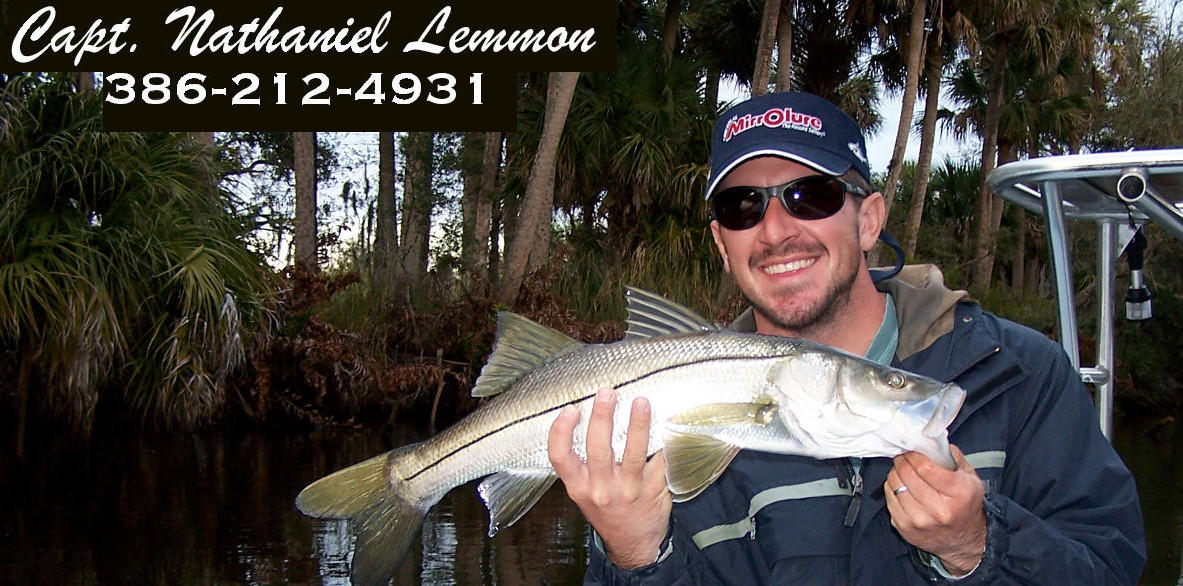
Snook Identification
Centropomus undecimalis, better known around Florida as the snook. There are actually 4 species of snook found in Florida. (Common Snook, Fat Snook, Swordspine Snook, and Tarpon Snook) A snook is easily identifiable by the dark black line that runs the length of its body on each side and the high divided dorsal fin. Their pike-like body is very light in color, generally olive with silver sides and belly and yellowish-green tail and fins. Ocean snook tend to be more silver while those found in the coastal inshore backcountry are darker.
Snook can live close to 20 years and reach lengths up to 50 inches. The average snook that anglers find attached to their line ranges from 2-5 pounds. An adult snook can reach weights up to 50-60 pounds in some parts of the world, even here in Florida. The current Florida all-tackle record is 44 pounds and was caught in the Ft. Myers area. There have been snook caught in Florida over 50 pounds, however none have been certified by the IGFA. The all-tackle IGFA world record is 53 pounds and was caught 30 years ago in Costa Rica. Florida maintains a slot limit (28-32”) and also has closed seasons that protect snook during their most vulnerable time.
As early as 2-4 years old, 18-24 inches long, snook become sexually mature. Interestingly enough snook are hermaphroditic and will exhibit male-to-female sex reversal as they become older. This adaptation keeps entire populations from being wiped out when times get tough (i.e. cold weather, drought, or limited food sources.) This sex change usually occurs between 1 and 7-years-old. Because of this most of the larger, older adult fish over 30 inches are female and most of the younger, smaller adults are males. Upon reaching sexual maturity snook migrate each summer to inlets and nearshore waters to spawn. Spawning occurs each year from May through September. November through March typically tends to be the best time of year to catch the most snook per day and get a photo taken of Snook in the New Smyrna Beach area, Mosquito Lagoon or Indian River Lagoon.
Where to Find Snook
Snook are native to the coastal waters of the western Atlantic Ocean, Pacific Ocean and Caribbean Sea. They are highly sensitive to water temperatures, severely stressing in waters below 60 degrees. For this reason they generally are found south of Daytona Beach and Tampa in Florida, although catches in North Florida and Texas are not unheard of.
While snook are considered an inshore fish, they can be found in saltwater or freshwater and it's in this mix that snook spend a majority of their life. This is why it is popular to fish for Snook near New Smyrna Beach/Ponce Inlet. Snook are quite current and structure oriented fish. They are often found under docks, along jetties, under bridges, on ledges along deep banks, creeks and channels. Snook prefer fast moving water that allows them to ambush prey. Snook can be found wifely scattered in Mosquito Lagoon and the Indian River during the summer months. Later in the fall and winter they will be found in deep holes, creeks and channels around Ponce Inlet, New Smyrna Beach, and Titusville.
Fishing for Snook in Florida
Snook are prized game fish known for their finicky behavior and powerful fights on light tackle. Equally as regarded, they are prized table fare. Sometimes they are referred to as the saltwater version of the largemouth bass on steroids. This is probably more so because of the type of structure they prefer and the techniques used to catch them, both of which are very similar bass fishing. Once hooked, snook have the uncanny ability to immediately head for the sharpest structure they can find which spells doom for an angler with a slow reaction or response. If being wrapped around barnacle encrusted docks, bridges, or a mangrove isn't enough, snook possess razor sharp gill plates that will quickly break off any line that becomes wrapped around it. Snook can be caught using a variety of gear. They are a favorite of fly anglers and light tackle anglers using plugs, jigs, and soft plastics. They also can be caught using live bait such as pinfish, mullet, croakers, sardines, and herrings. Regardless of what used to pursue them, snook are very finicky and require a good dose of “teasing” in order to produce a strike.
The Mosquito Lagoon, Indian River, and Ponce Inlet area may not have as many snook as the souther part of the Florida. Years have mild winters have steadily increased snook populations around the area. Winter months are the best time to catch lots of snook in the Mosquito Lagoon, Indian River and near New Smyrna Beach. Snook school up in big numbers during the winter and these local snook hang outs routinely give up double digit days and snook reaching over 10 pounds.
Capt. Nathaniel Lemmon is a full-time snook guide who specializes in fishing charters for snook on the Indian River, Mosquito Lagoon, Spruce Creek, and areas around Ponce Inlet and New Smyrna Beach. Snook of various sizes can be caught here using a variety of live baits like shrimp, pinfish and mullet as well as jigs, plugs and flies. Snook fishing charters run daily from any one of several launch locations within easy driving distance of Daytona Beach, New Smyrna Beach, Ponce Inlet, Edgewater and Titusville Florida.







